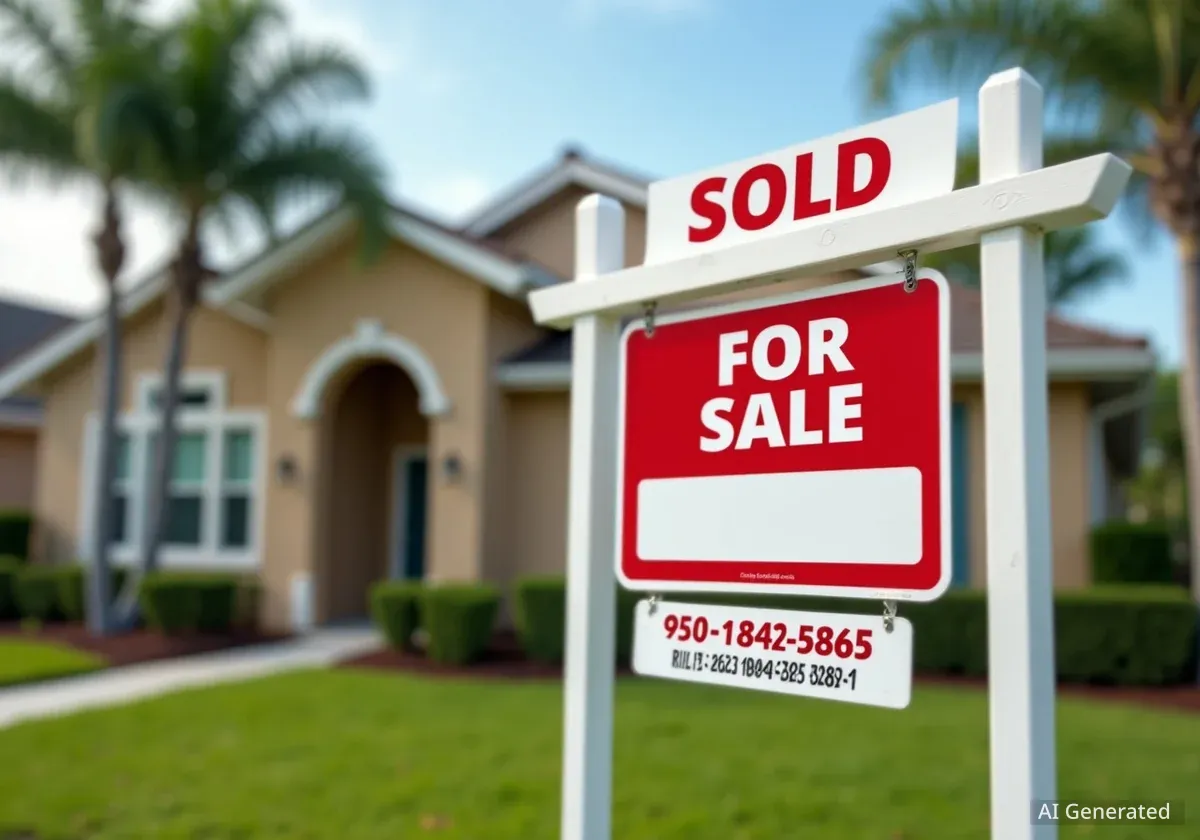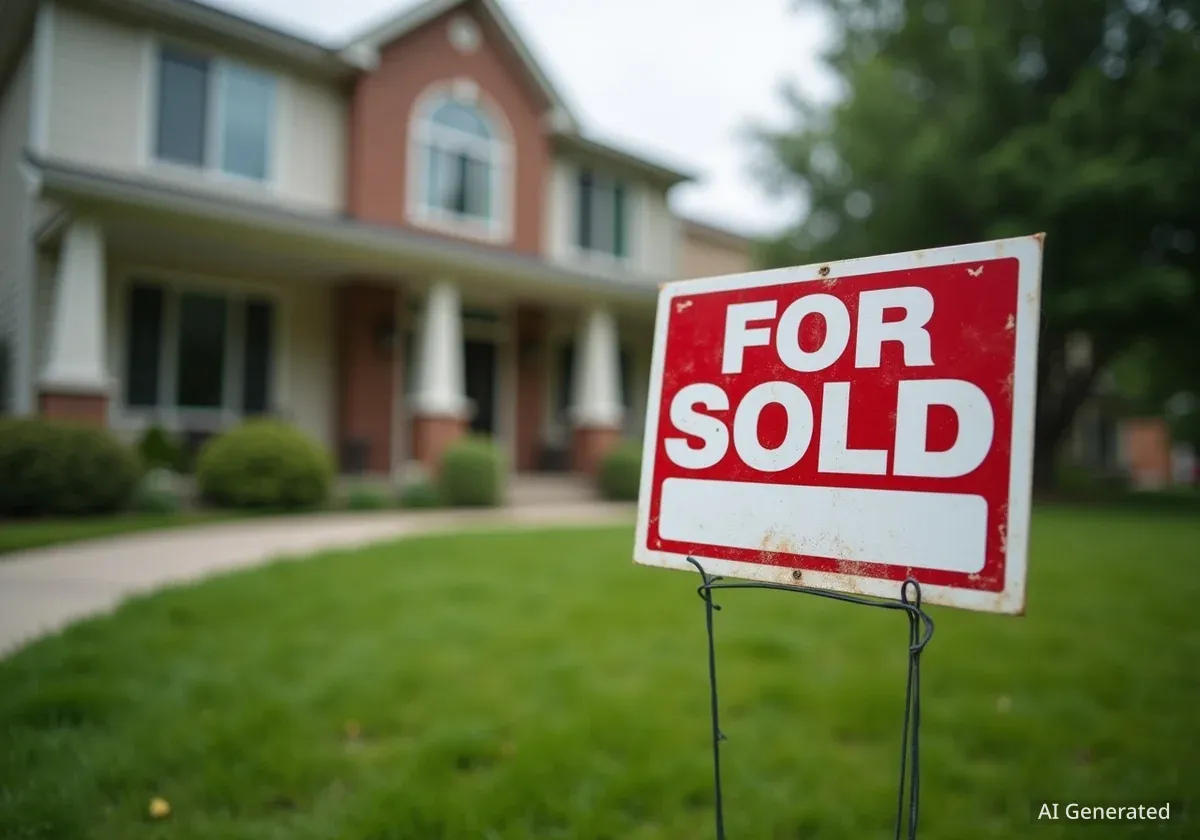Mortgage rates for all major loan types increased on September 21, 2025, raising borrowing costs for potential homebuyers. The national average for a 30-year fixed-rate mortgage reached 6.60%, continuing an upward trend that defies a recent interest rate cut by the Federal Reserve.
This development highlights the complex relationship between Federal Reserve policy and consumer lending rates. While the Fed adjusts short-term rates, mortgage rates are more closely linked to long-term Treasury yields, which have risen due to market concerns about inflation.
Key Takeaways
- The average rate for a 30-year fixed mortgage rose to 6.60% on September 21, 2025, an increase of 15 basis points from the previous week.
- Rates for 15-year fixed mortgages and adjustable-rate mortgages (ARMs) also saw increases.
- The rise occurred just days after the Federal Reserve cut its benchmark interest rate by 25 basis points on September 17.
- Mortgage rates are primarily influenced by the 10-year Treasury yield, which has been driven higher by inflation concerns and investor sentiment.
- Refinance rates remain elevated, with the 30-year fixed refinance rate at 7.00%.
Current Mortgage and Refinance Rates
As of September 21, 2025, borrowing costs have climbed across various loan categories. This includes conventional fixed-rate loans, adjustable-rate mortgages, and government-backed loans. The increases reflect broader market volatility and investor reactions to economic data.
Snapshot of Today's Purchase Mortgage Rates
The most popular home loan, the 30-year fixed-rate mortgage, experienced a notable jump. The rate climbed to 6.60%, up from 6.52% the previous day and 6.45% just one week ago. This marks a significant change for buyers currently in the market.
Other loan types also saw upward movement:
- 15-Year Fixed-Rate Mortgage: The rate for this shorter-term loan rose to 5.86%.
- 5-Year Adjustable-Rate Mortgage (ARM): The initial rate for a 5-year ARM increased to 7.19%.
Government-Backed Loan Rates
Rates for loans insured by government agencies also increased. The average rate for a 30-year fixed FHA loan surged to 7.50%, while the 30-year fixed VA loan rate moved to 6.13%. These loans are often used by first-time homebuyers and military veterans.
Refinancing Costs Remain High
Homeowners looking to refinance are also facing elevated rates. While the 30-year fixed refinance rate saw a very slight dip to 7.00%, it remains significantly higher than rates seen in previous years. The 15-year fixed refinance rate edged up to 5.88%.
The current rate environment makes refinancing less attractive for many homeowners who secured lower rates in the past. High refinance rates limit the potential for monthly savings, a primary motivator for refinancing.
Understanding the Disconnect with the Federal Reserve
A key point of confusion for many is why mortgage rates are rising when the Federal Reserve just cut its benchmark interest rate. On September 17, 2025, the Fed lowered its key rate by 25 basis points in what it called a “risk management” move to support the economy.
Fed Rate vs. Treasury Yields
The Federal Reserve's rate directly influences short-term borrowing, such as credit cards and auto loans. However, it does not directly set mortgage rates.
Instead, mortgage rates tend to follow the yield on the 10-year Treasury note. This is because mortgages are long-term loans, and investors in mortgage-backed securities demand a return that is competitive with other long-term, low-risk investments like Treasury notes.
Why Did Treasury Yields Rise?
Following the Fed's rate cut, the yield on the 10-year Treasury note actually increased. This happened because investors are more concerned about persistent inflation. They believe the Fed's rate cut might not be enough to control inflation in the long term, so they are demanding a higher return (yield) for holding long-term government bonds. This, in turn, pushes mortgage rates higher.
Market expectations also play a crucial role. Some investors may have anticipated a more aggressive rate cut from the Fed. When the cut was smaller than hoped, it signaled to the market that the Fed might be less aggressive in the future, leading to a recalibration of long-term bond yields.
Impact on Homebuyer Affordability
The increase in mortgage rates directly affects the monthly payments for homebuyers, impacting overall housing affordability. A small change in the interest rate can add a significant amount to the total cost of a home over the life of the loan.
Example Calculation
To illustrate the impact, consider a homebuyer taking out a $300,000 loan for a 30-year term.
- At last week's average rate of 6.45%, the monthly principal and interest payment would be approximately $1,895.
- At today's average rate of 6.60%, the monthly payment increases to approximately $1,916.
This difference of $21 per month adds up to $252 per year. Over the full 30-year term of the loan, the borrower would pay an additional $7,560 in interest. This calculation demonstrates how even minor rate fluctuations can have a substantial financial impact.
Expert Forecasts and Market Outlook
Economic experts and housing organizations are closely monitoring the market. While there is consensus that volatility will continue, most forecasts suggest a gradual easing of rates heading into 2026, contingent on inflation trends and economic stability.
The National Association of REALTORS® projects that mortgage rates will average 6.4% in the second half of 2025 and decline further to around 6.1% by 2026.
Other major institutions have provided similar outlooks:
- Fannie Mae: In its August 2025 forecast, the organization revised its expectations slightly upward, predicting rates near 6.5% by the end of 2025 and 6.1% by 2026.
- Mortgage Bankers Association (MBA): The MBA anticipates a 30-year mortgage rate of 6.7% by the end of 2025, before falling to 6.5% in 2026.
- Realtor.com: Their forecast suggests rates will slowly ease, potentially aligning with the previous year's average of around 6.4% by the end of the year.
These forecasts indicate that while relief may be on the horizon, homebuyers should expect rates to remain elevated for the remainder of 2025. The market's direction will largely depend on future inflation reports, employment data, and investor confidence in long-term bonds.





